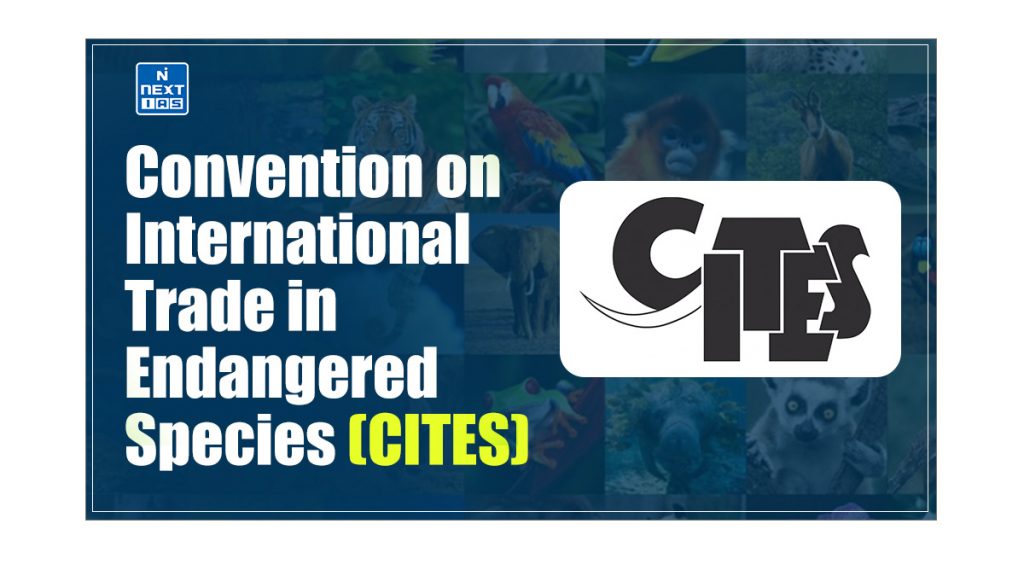
The Convention on International Trade in Endangered Species of Wild Fauna and Flora (CITES) is an international agreement to regulate and monitor the trade of wildlife and plants to prevent their over-exploitation. Its significance lies in its role as a global framework for protecting species from the adverse impacts of international trade and fostering international cooperation to ensure their survival. This article aims to study in detail the history, objectives, membership, administrative structure, classification of species, legal framework, and limitations of CITES in safeguarding global biodiversity.
About CITES
- The Convention on International Trade in Endangered Species of Wild Fauna and Flora (CITES) is a vital international agreement that ensures global trade in wildlife and plants does not threaten their survival.
- By creating a framework for regulating and monitoring trade, CITES seeks to balance conservation needs with those of sustainable economic development.
- The convention is a collaborative effort among countries to protect the world’s most vulnerable species from exploitation and promote international cooperation in wildlife conservation.
History of CITES
- The idea for CITES emerged from increasing concerns about the impact of international trade on endangered species.
- In the early 1960s, there was growing awareness of the threats posed by unregulated wildlife trade, leading to significant declines in various species populations.
- This growing concern highlighted the need for a coordinated global approach to address the exploitation of wildlife and plants.
- CITES was conceptualised in 1963 at the International Union for Conservation of Nature (IUCN) meeting.
- The need for a global framework to regulate international trade in endangered species led to the formation of the convention.
- Hence, CITES was formally adopted and came into force in 1975.
Objectives of CITES
The objectives of CITES are as follows:
- To ensure that international trade in specimens of wild animals and plants does not threaten the species’ survival in the wild.
- CITES provides varying degrees of protection to more than 34,000 species of animals and plants, helping to prevent over-exploitation and ensuring their continued survival.
- To control the export, import, and re-export of endangered and threatened wildlife.
- To promote the sustainable use of wildlife and plants by ensuring that trade does not adversely impact their populations.
- To foster international cooperation and collaboration among member countries.
- To support and complement national conservation efforts by providing a global framework for wildlife protection.
- To monitor and evaluate the impact of international trade on species populations and their habitats.
Membership of CITES
- CITES currently has 183 member countries that adhere to its regulations.
- These countries are responsible for implementing national legislation to enforce CITES’ rules and regulations within their borders.
- The Convention is administered by the United Nations Environment Programme (UNEP) and is headquartered in Geneva, Switzerland.
Administration of CITES
- The Convention of the Parties (CoP) is the supreme decision-making body, consisting of all member countries, and meets every two to three years to review and update the provisions of CITES.
- Additionally, the CITES Secretariat, based in Geneva, is crucial in coordinating activities, facilitating communication among parties, and supporting the implementation of the Convention’s objectives.
Classification of CITES Appendices
The species are listed under the three CITES Appendices that are mentioned below:
- CITES Appendix-I: It includes the species that are in danger of extinction. E.g. Asiatic lions and tigers (tiger skin trade).
- CITES Appendix-II: It includes the species that aren’t facing imminent extinction but need monitoring so that any trade doesn’t become a threat. E.g. American Alligators (Alligator skin trade).
- CITES Appendix-III: It includes the protected species in at least one country. E.g. Honeybadger (medicinal or bushmeat purpose).
Legal Framework and Implementation of CITES
- Although CITES is legally binding on its Parties, it does not replace national laws.
- Instead, it provides a framework that each Party must respect. Countries must adopt and enforce domestic legislation to ensure the effective implementation of CITES nationally.
- Each Party must establish a Management Authority to oversee the species trade listed in the CITES appendices and a Scientific Authority to advise on the trade’s impact on species populations.
- Parties are responsible for issuing permits and certificates for trade, ensuring compliance with CITES regulations, and reporting on their implementation efforts to the CITES Secretariat.
- This decentralised approach ensures that while CITES sets global standards, individual countries are responsible for enforcement.
Importance of CITES
- The Convention on International Trade in Endangered Species of Wild Fauna and Flora (CITES) is vital for the conservation of global biodiversity.
- By regulating and monitoring trade, CITES helps protect vulnerable species from exploitation and extinction, maintaining ecological balance.
- The convention promotes international cooperation, as member countries work together to implement regulations and share information.
- CITES raises awareness about the importance of biodiversity and the impact of trade on endangered species, fostering a global commitment to sustainable practices.
- Ultimately, CITES plays a crucial role in safeguarding wildlife for future generations while supporting the livelihoods of communities that depend on natural resources.
Limitations of CITES
The limitations of CITES are as follows:
- CITES relies on member countries’ voluntary compliance, leading to inconsistent enforcement and varying levels of commitment.
- CITES primarily addresses international trade, overlooking other significant threats like habitat loss and climate change.
- Insufficient resources, weak national legislation, and political will hamper effective enforcement.
- Legal trade can sometimes be exploited or cause unintended negative impacts on species.
- Limited financial resources and support affect the Convention’s operational effectiveness.
- Reporting and data quality variability can undermine monitoring and enforcement efforts.
Conclusion
CITES plays a crucial role in the global effort to protect endangered species from the threats of international trade. Strengthening member commitments and integrating CITES with broader conservation strategies will be vital in enhancing its effectiveness and ensuring the survival of vulnerable species for future generations.
Frequently Asked Questions (FAQs)
What is the Convention on International Trade in Endangered Species?
CITES is an international agreement ensuring international trade in wild animals and plants does not threaten their survival, thereby promoting biodiversity conservation and sustainable use.
What is the full form of CITES?
The full form of CITES is the Convention on International Trade in Endangered Species of Wild Fauna and Flora.
Why is CITES important?
CITES is important because it helps protect endangered species from overexploitation, promotes international cooperation in conservation efforts, and raises awareness about biodiversity preservation.






